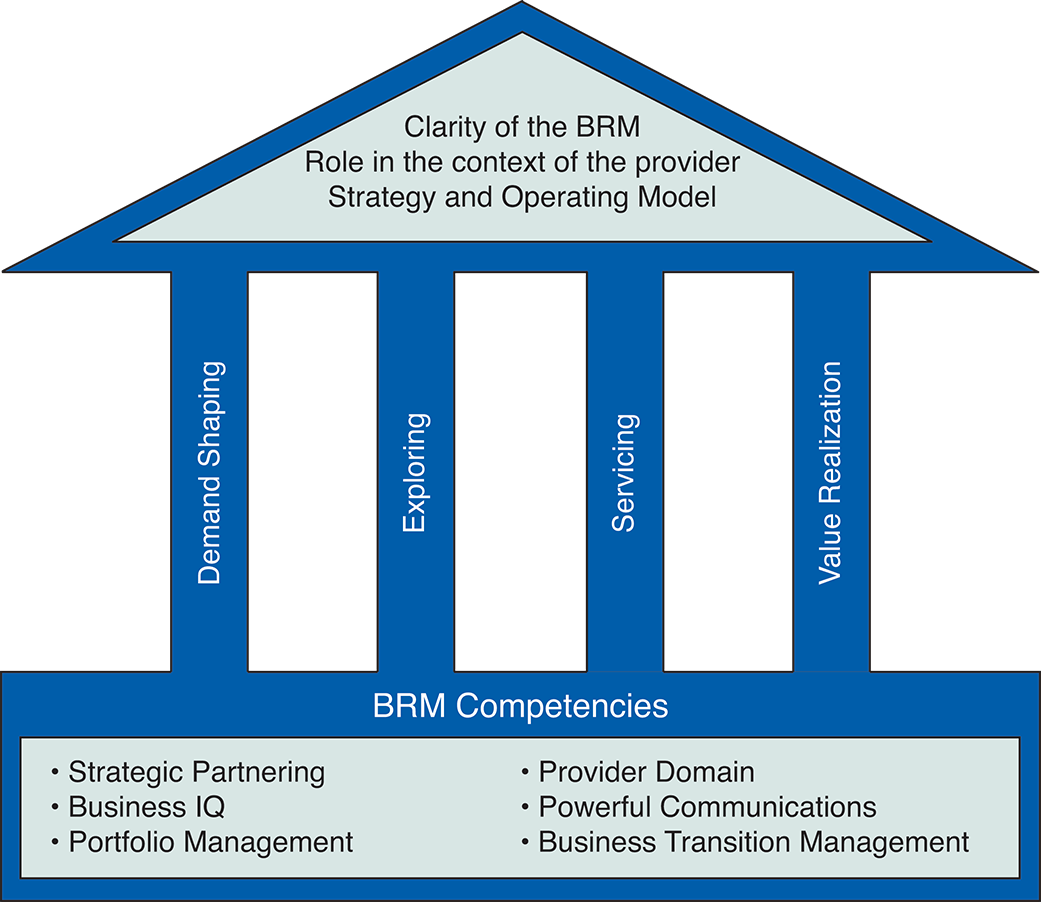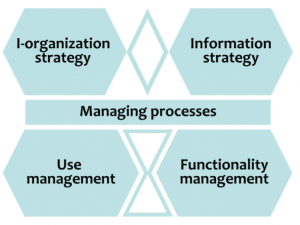BRMBoK™ and BiSL® in 3 minutes
Maximizing business value from investments in information and technology
 This is a brief overview of the enhanced opportunities for business value from investments in information and technology that enterprises can unlock by combining the guidance provided in Business Relationship Management Institute’s BRMBoK™ with the ASL BiSL Foundation’s Business Information Services Library (BiSL®). The explicit distinction between information and technology emphasizes that the business needs information, and that technology is the enabler. Information and technology are intimately intertwined, yet each needs to be managed in its own right. The business is responsible for deciding what information and capabilities they need, and their IT partners are responsible for enabling the business to leverage the best available technology. Mutual understanding and close collaboration is crucial for maximizing business value from investments in these two business assets. BRMBoK and BiSL offer guidance from differing yet complementary perspectives in pursuit of a common goal. The Business Relationship Management Institute and the ASL BiSL Foundation offer more guidance and support such additional publications, training and certification programs, webinars, and conferences.
This is a brief overview of the enhanced opportunities for business value from investments in information and technology that enterprises can unlock by combining the guidance provided in Business Relationship Management Institute’s BRMBoK™ with the ASL BiSL Foundation’s Business Information Services Library (BiSL®). The explicit distinction between information and technology emphasizes that the business needs information, and that technology is the enabler. Information and technology are intimately intertwined, yet each needs to be managed in its own right. The business is responsible for deciding what information and capabilities they need, and their IT partners are responsible for enabling the business to leverage the best available technology. Mutual understanding and close collaboration is crucial for maximizing business value from investments in these two business assets. BRMBoK and BiSL offer guidance from differing yet complementary perspectives in pursuit of a common goal. The Business Relationship Management Institute and the ASL BiSL Foundation offer more guidance and support such additional publications, training and certification programs, webinars, and conferences.
While this publication focuses on the domain of information and technology, it should be noted that BRMBoK can be used in other resource provider domains such as HR, Finance, and Legal. This wider application does not apply to BiSL.
As with every other resource in an enterprise, there are activities for determining the demand for information and technology, supplying and effectively using them. When demand for a resource originates in one organizational unit (e.g. the business) and its supply is provided by another (e.g. IT department), the consumer and provider must interact effectively and efficiently to realize maximum business value from the consumed resource. This interaction can be viewed from two interrelated perspectives: the relationships established between the parties and the level of active collaboration based on these relationships. Collaboration is at strategic, tactical and operational levels. Virtually every autonomous business unit within an organization uses information systems, while supply is provided by a combination of centralized or decentralized internal IT and external IT service providers. This introduction sketches the context in which the insights contained in BRMBoK and BiSL might be best applied.
BiSL provides guidance for business units with respect to demand and use of information systems, while BRMBoK enables IT and Business convergence moving IT to a strategic business partner with shared accountability for ensuring business strategy and business value results. As a single converged team, business and IT foster collaboration to shape demand and use at strategic and tactical levels. BRMBoK does not address the “internals” of supply of information systems but instead focuses on overall orchestration in pursuit of innovation and maximum business value results.
In summary, BRMBoK and BiSL offer complementary perspectives on the strategic and tactical activities of the business units with respect to demand and use of information systems. In addition to these strategic and tactical activities, BiSL also addresses business units’ operational activities regarding information systems. BRMBoK and BiSL both address the relationships between business units and internal IT providers. In addition to engaging with business partners, BRMBoK also coordinates internal IT providers’ supply activities.
BRMBoKTM
 The BRM Institute’s BRMBoK describes a set of competencies (e.g. knowledge, skills, and behaviors) to foster an effective business value-producing relationship between a provider and its business partners. These competencies can be leveraged through organizational roles (e.g. in an IT organization, the CIO typically has a role of BRM for the enterprise), a discipline (e.g. all business partner facing provider roles should be skilled in Business Relationship Management), and an organizational capability (e.g. a provider organization should be effective in shaping and channeling demand to the highest business value opportunities). The BRM Role is a crucial link between a provider and the business acting as a connector, orchestrator, and navigator between the provider and one or more business units.
The BRM Institute’s BRMBoK describes a set of competencies (e.g. knowledge, skills, and behaviors) to foster an effective business value-producing relationship between a provider and its business partners. These competencies can be leveraged through organizational roles (e.g. in an IT organization, the CIO typically has a role of BRM for the enterprise), a discipline (e.g. all business partner facing provider roles should be skilled in Business Relationship Management), and an organizational capability (e.g. a provider organization should be effective in shaping and channeling demand to the highest business value opportunities). The BRM Role is a crucial link between a provider and the business acting as a connector, orchestrator, and navigator between the provider and one or more business units.
The House of BRM illustrates three key aspects of Business Relationship Management:
- The “foundation” supports the BRM role and ensures it has the competencies to be effective and deliver value to both the provider organization and its business partners.
- The “pillars” define the BRM space in terms of Core BRM Disciplines: Demand Shaping, Exploring, Servicing and Value Harvesting.
- The “roof” of the House of BRM protects Business Relationship Management as a key aspect of provider capability. It does this by ensuring clarity around how the role, discipline and organizational capability of Business Relationship Management in the context of the Provider Strategy and Operating Model.
BiSL®
The non-profit ASL BiSL Foundation’s Business Information Services Library not only comprises a process model but also describes many best practices for its application. There is guidance on how to adopt and adapt the framework, and it’s supported by a training and certification scheme accredited by and available through APMG International. The ASL BiSL Foundation connects a diverse community of users, who are keen to share their knowledge. The Foundation further expands its reach through its network of ambassadors, who offer local support in 10 countries. BiSL has passed the test of time and is widely adapted in public and private organizations in the home market in the Netherlands. BiSL has also been successfully implemented outside the Netherlands, with one of the more recent adoptions being by IBM in Japan who used BiSL in a consultancy engagement for NTT Data.
 Winners of the annual ASL BiSL Foundation award report that among the benefits an organization can expect from using BiSL is a marked improvement in the core business outcomes. For example, the Dutch Police Force reported a reduction in criminality by being able to share information more effectively. Other reported benefits from using BiSL include improvements in business interactions with the IT function. For example, a university reported improved business satisfaction with their IT department due to better involvement and influence. Finally, organizations implementing BiSL see tangible information system benefits. An insurance company lowered costs and risks related to information systems as a result of BiSL framework implementation.
Winners of the annual ASL BiSL Foundation award report that among the benefits an organization can expect from using BiSL is a marked improvement in the core business outcomes. For example, the Dutch Police Force reported a reduction in criminality by being able to share information more effectively. Other reported benefits from using BiSL include improvements in business interactions with the IT function. For example, a university reported improved business satisfaction with their IT department due to better involvement and influence. Finally, organizations implementing BiSL see tangible information system benefits. An insurance company lowered costs and risks related to information systems as a result of BiSL framework implementation.
The BiSL framework addresses operational, management as well as strategic activities related to information management. The BiSL process cluster Use management comprises processes that support the day-to-day activities such as ensuring that users use the IS effectively and efficiently. Functionality management ensures that new or changed functionality is created. The Managing processes keep resources and quality under control. Information strategy takes a longer-term perspective and considers information in terms of lifecycles and portfolios. In I-organization strategy, all of the above activities and processes are well-organized.
BRMBoK’s contribution to users of BiSL
Because BRMBoK is specialized in fostering productive relationships, users of BiSL can benefit from this guidance in order to manage their relationships with the user organization, partners in the information chain, and IT providers. They also benefit from the fact that their internal IT service provider uses BRMBoK because this makes it much easier to collaborate with each other.
BiSL’s contribution to users of BRMBoK
Because BiSL describes the business unit’s activities with respect to demand and use of information systems, BiSL gives users of BRMBoK a better understanding of the activities on which they are collaborating with their business partners. Users of BRMBoK also benefit from their business partners using BiSL to become a better ‘dancing partner’.
Further information
www.brm.institute
The BRMP® Guide to the BRM Body of Knowledge, ISBN: 9780997761825 BRMBoK is available for Professional Members of BRM Institute.
www.aslbislfoundation.org
BiSL, A Framework for Business Information Management, 2nd edition, ISBN: 9789087537029
BiSL Pocket Guide, 2nd edition, ISBN: 9789087537111 (free e-book version available via http://bit.ly/1Qs7jrI)
Copyright
BRMBoK™ is a trademark of BRM Institute.
BiSL® is a registered trademark of the ASL BiSL Foundation.
The BRMBoK content of this publication is the intellectual property of BRM Institute.
The BiSL content of this publication is the intellectual property of the ASL BiSL Foundation.
The BRMBoK-BiSL content of this publication is the joint intellectual property of BRM Institute and the ASL BiSL Foundation.
4-10-2015